I did not write this post. The title’s “Mother” is my grandmother, Ruth Radman Meyer; “Me” is my mother, Bernice Meyer Saltzman. My mother wrote and delivered this speech in February 1995. Fifteen years later, I am still impressed and inspired every time I read it. This tribute to my grandmother is also a testament to my mother’s outstanding abilities as a scholar, writer and parent. I am publishing it this week to honor my mother’s memory on her 10th yahrzeit (anniversary of her death).
Truths My Mother Taught Me
Presented by Bernice Meyer Saltzman
to the Jewish Women’s Club of Richmond VA
Tuesday, February 28, 1995
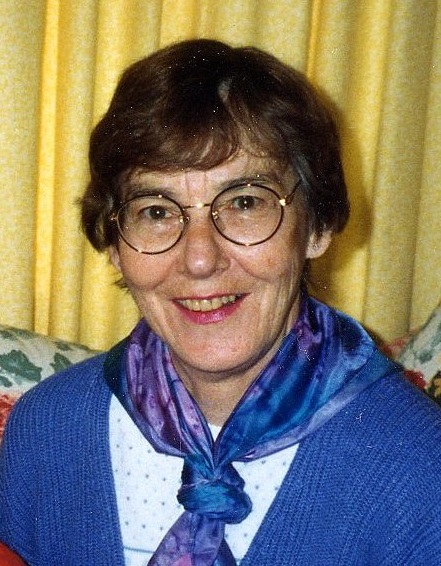
One of the blessings of being sixty-something is that you are in the position of learning from people both older and younger than you. Recently the young 39-year-old Rabbi Simeon Glaser of my synagogue in West Hartford titled his shabbat sermon, “Truths My Father Taught Me.” I quickly saw a variation of this title as appropriate for my presentation to the Jewish Women’s Club. I also liked the title because “Truths” contains my mother’s name (Ruth Meyer).
My rabbi’s father, Rabbi Joseph Glaser, had died at age 69 two months before his son gave this sermon. I think this particular sermon, not in any way a eulogy but rather a loving exposition of his father’s ideals, advice and actions, may have been part of my rabbi’s grief-healing process.
My mother died a year and a half ago at age 85. My grieving process actually began about two years before she died, when I saw her becoming very frail and started to think what life would be like without her. From that time I began sorting and organizing with her during my visits, her vast collection of memorabilia and photographs, a joint project that gave her much pleasure. (Ruth was probably the only teenager of her generation who owned and used a box camera and she saved everything!). I’ve continued the sorting and organizing on visits since her death. It’s an activity that keeps her present in my life and made it easy for me to accept the invitation to speak to this group because so much of what she saved relates to the JWC. I believe that this presentation marks the end of my grief-healing process. Its preparation has been an opportunity to think about, without grief or sadness, what my mother taught me about Judaism and about living.
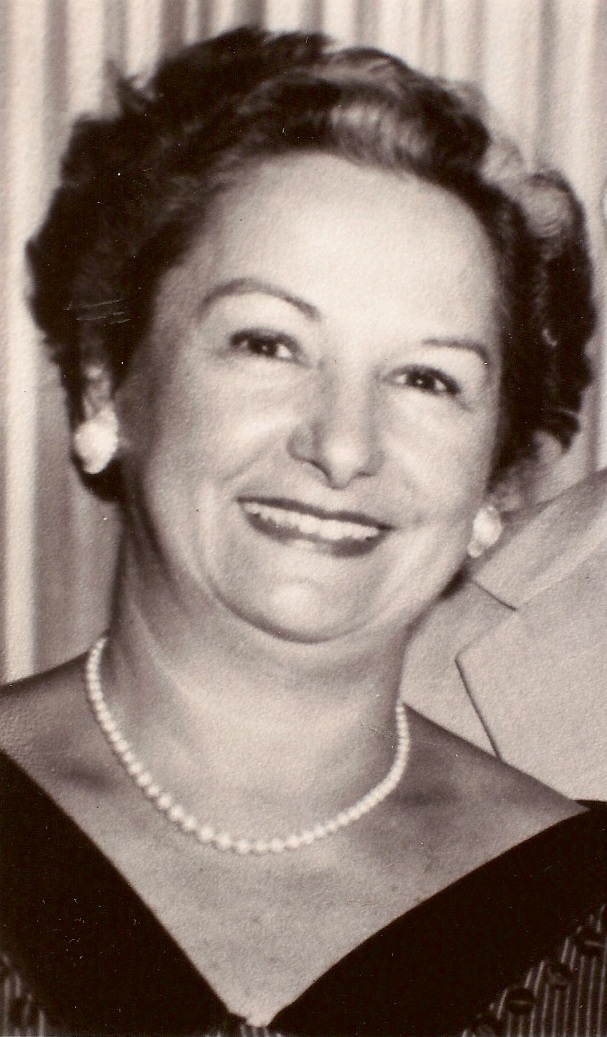
I owe this opportunity to my dear-friend-since-childhood, Martele Sporn Wasserman, who thought of me when she was assigned to program this meeting and who suggested I build the topic on my mother as my first and best teacher.
[I always have a wonderful sense of continuity whenever I’m in Richmond. It comes from the fact that I and my five childhood friends, Jo Elsner Adams, Jena Rosenbloom Sager, Doris Tartarsky Abraham, Dore Abramson Trestman, and Martele, never disconnected from one another though some of us left Richmond after marriage. We could look back to our mothers who were also friends from their youths, maintaining lifetime ties either in the JWC, the Temple Sisterhood and other organizations, vacations at Virginia Beach or around the bridge table. And today some of our children who became friends in childhood continue to keep in touch. With the passing of Martele’s mother, Jean, last November 11, all of our mothers are now gone. Gone also is our beloved Dore who died shortly after her 64th birthday. All of these wonderful women, the mothers and the daughters, are in my thoughts today.]
• • • • •
Jews know that Torah means much more than the Five Books of Moses. For us Torah includes the entire Bible and Talmud and all the products of the study of these treasures: midrashim, translations of Scripture, the Prayerbook, rabbinic responsa, ethical wills (sometimes even bubba meises). The rabbis further decreed that Torah is also to be found in the actions of any righteous person.
Another rabbinic formulation of the concept that one teaches best and most by example is their phrase, ma’aseh avot siman l’banim. “The deeds of the parents are a sign (or beacon) to the children.” The Ramban (Nachmonides) and other commentators used the phrase to describe the chapters in Genesis about the patriarchs, specifically to the fact that so many incidents in the life of Abraham are repeated or emulated in the life of Isaac and Jacob.
Of course, my life has not been a repeat of my mother’s life. But her deeds have been and are a beacon and a model for me. Though I adore and admire my father for the constant and consistent devotion he has given to me all my life, I know he’d be the first to say that my mother was the one who transmitted the values and verities of Judaism to my brother and me.
Like her Biblical namesakes, my mother, Esther Ruth Meyer, was determined, intelligent, modest and loyal. She taught me much of what I know about living – from the facts of life (when I was 10) to how to accept old age and death with grace and dignity. She showed me that Judaism is a source of strength and inspiration and informs almost everything we think about and must do in our world.
How did she become such a source of wisdom and a sign for the way? She was born and raised in America as the eldest daughter of a typical East European immigrant Jewish family. Parnassa, earning a living, took precedence over religious observance and education. The only educational “enrichment” my mother received was several years of piano lessons, the seed, no doubt, of her lifelong love of classical music. However, Jewish holidays and life cycle events, Yiddish, tzadakah, kaddish, supporting the shul, etc., were real and present in her life from birth. They surely had a great deal to do with her and Leonard joining the small band of young families that founded Richmond’s first Conservative synagogue in 1933.
In that same year Ruth became one of the eight (some papers show ten, some eleven) young women who started the Jewish Women’s Club, dedicated then as now to learning.
In the last 10-15 years we’ve become familiar with such phrases as continuous education, adult education, personal growth, self-help or support groups, and women’s issues. I have long admired and marveled that the Jewish Women’s Club, founded as a weekly study group, pioneered these concepts before anyone put a name to them. I have no doubt that the JWC was Ruth’s “learning center” where she gained the equivalence of the college education that gender and poverty had denied her, where she acquired many of the skills that enabled her to cope with marriage, motherhood and maturity, where she harvested the truths that informed and enhanced her Jewish identity.
• • • • •
My mother had some choice guidelines on derekh eretz, decency or acceptable behavior. Actually she expressed many of them in timeworn cliches. But, reflecting on them the past year and a half, I know they had solid Jewish underpinnings. I’ll share a few with you.
How many times I heard “If you can’t say something nice about someone, don’t say anything.” According to the Talmud (Arakhin 15b), lashon hara – the evil tongue or slander, is a hideous capital crime. The sages remind us that slander kills three persons: the one who tells it, the one who accepts it, the one about whom it is told. One of my favorite condemnations of slander is by Ben Sira (19:10): “If you hear something said, let it die with you; have courage, it will not make you burst!”
“Everything happens for the best.” Gam zu letovah, the Jewish formula for accepting misfortune. Ruth applied this to the 15-year old (me) who didn’t get invited to the TJ Cadet Hop or on dates by boys taller than I, and was still saying it 30 years later when one of our three children, – our only daughter– moved to Israel. But this was Ruth’s version of bittahon betuv haolam, the unshakeable, invincible optimism of the Jews, based on our trust and faith in a good and just God ruling the world and on our conviction that the world that God created is good, in fact “very good” (Gen. 1:31).
“Don’t judge a book by its cover.” This of course can refer to people or places. I think of it, however, as my mother’s particular brand of rachmanut, compassion, the ability to mature beyond self-centeredness, to grow out of oneself and into someone else, to accept another’s pain as one’s own. I have a very old memory that relates to this: I am about 6 or 7, standing under an umbrella with my mother in a heavy rain waiting for a bus at 6th and Broad Streets to take us home from shopping in Thalheimers. A black woman, a total stranger to my mother and without an umbrella, is also waiting for the bus. My mother takes the woman’s arm and gently draws her under our umbrella. I remember my mother said something like, “come on under here, you’re getting soaking wet.”
The deeds of my mother were just as instructive as her sayings. Kibbud Av v’Em – honoring parents. I was greatly blessed to have three grandparents who lived until my early twenties and who lived in Richmond. In their acts and their attitudes, my mother and father were united in their devotion, concern and practical help to each of these three parents.
If my mother had one legendary practice, it was hospitality, in Jewish tradition one of the essential mitzvot. Ruth was not a great cook. Oh, she had her specialities, but my father’s superior skills at the stove were acknowledged long ago. But she was a master at producing a sumptuous spread on short notice for unexpected company. And unexpected company was always expected to stay for a meal! Somehow she always had on hand cans of tuna and salmon, the makings for salads, cheeses, pickles and pastries. (and of course, beef tenders, hot dogs and hamburgers for a bar-b-q!) Moreover, her presentation of the meal could be the envy of the best caterer in town. And not only did I frequently share my bed with visiting girl cousins and aunts for a night or two, but several times in my early youth, I did so for weeks at a time while family relatives relocating to Richmond looked for jobs and housing of their own.
Thanks to her studies in child psychology under the aegis of the Jewish Women’s Club, Ruth gained good reinforcement for her instincts regarding child raising. She was definitely averse to instant gratification. I had a hard time understanding why I couldn’t have a skirt for each day of the week, like Martele. “Her father’s a tailor so she can have seven skirts,” Ruth told me. “Your father’s a butcher. You eat meat every day.”
She always encouraged me to dare to be different, not to follow the herd, to not be ashamed of my intelligence. My love of words and writing skills got their first nurture from her when I was about 12. Recognizing that I had a hard time falling asleep because I couldn’t turn off my brain, she put a notebook on the table by my bed and said, “if you can’t sleep, write.” When I had last minute anxieties about attending such a large school as Syracuse University, my mother came up with a gem of reassurance: “Don’t worry about the school’s bigness,” she said. “Quality never gets lost in quantity.”
Her concern for the muscular-skeletal system of her unusually tall (for that era) leinge-lugs of a daughter had me sleeping on a horsehair mattress (maybe that’s why I couldn’t fall asleep), doing exercises to prevent curvature of the spine and walking up and down the stairs with a book on my head. “Stand Up Straight!” are three words I must have heard every day of my life until I left home for college.
She never could fathom, but always seemed pleased, that she had a daughter so physically unlike herself. And I never appreciated her lifelong battle with obesity until the hormonal changes of menopause finally increased me to a size 14 while illness and old age finally reduced her to a size 12.
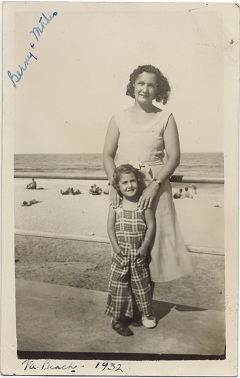
• • • • •
After the destruction of the Second Temple in 70 c.e., Rabbi Yochanan ben Zakkai decreed that henceforth study and deeds of loving kindness would stand in place of sacrifice. I think the most Jewish thing my mother did all her life was torah lishmah, study for its own sake and study that leads to good deeds. I can’t say that I knew as a young child or teenager how important the Jewish Women’s Club was to her. (I was 4 years old when the Club began; my brother was a three-month-old infant.) But I always saw three or four books on her night table and I knew that she read until the wee hours of the morning. (She occasionally joked that my father’s snoring kept her awake so she read until he went to work at 4 a.m. then she went to sleep. )
Through the Jewish Women’s Club her knowledge and understanding of philosophy, history, literature, psychology, art, and Judaism grew wide and deep. Books, in which she made marginal notes, underlined passages, and saved recipes, newspaper and magazine clippings, and letters from her grandchildren, were her constant and lifelong companions. Because she loved to read and to listen to music, Ruth was never bored or afraid to be alone.
Her lifelong interest in and love of the game of bridge began a year or two earlier than her involvement in the JWC. Because she loved playing bridge, she could go to any town – including visits to us in Hartford – and find compatible people to be with. I finally came to appreciate the benefits of bridge for my mother when my husband and I started square dancing 25 years ago. When you are square dancing, like when you are playing bridge, your troubles stay home. You can go anywhere and dance. The steps and the rules are the same the world over. You are with people and you have fun. Unlike square dancing which is physically taxing, bridge was the one thing Ruth could do when physically she could do very little. I bless the game for the pleasure and the mental sharpness it gave my mother to the last week of her life.
Ruth carried her Jewish identity into the bridge world, too. I’ve come to think of her as an emissary to the many non-Jews she met playing bridge, often their sole source of information about Jewish observance and holidays. Some even asked her to speak to their church study groups from time to time.
I’ve never been sure why she was so successful at bridge. She rarely reasoned in a logical, sequential way. But she was very good at math (“all you gotta do is count to 13”). She was not a visionary, but she was a visualizer. She could “see” where the cards were. I read somewhere that one strategy for achieving success in whatever you choose to do is to visualize or fantasize yourself in a given situation or with a given problem and then see yourself working your way through it.
• • • • •
A few weeks ago we read Parashat Yitro, the Torah portion that contains the covenantal event at Sinai. In Exodus 19.3, as the people gather at the foot of Mt. Sinai preparatory to receiving the Ten Commandments, God speaks thus to Moses: “you shall say to the House of Jacob and declare to the children of Israel. . . “. A rabbinic midrash to this verse (Exodus Rabbah 28:2) says that “House of Jacob” signified the women and “children of Israel” signified the men. The rabbis asked, “why did God mention the women first?” The answer: “Because women are prompter in fulling the commandments. Another explanation: because they will teach the children.”
To me there’s a profound discrepancy in the rabbinic attitude that women are the teachers. From the time of Sinai until the time of my mother’s generation, only rarely did the Jewish woman receive the tools to teach. If the dictum is true, that “when you educate a man you educate a person; when you educate a woman, you educate a family”, how then did women acquire their knowledge? The founders of the Jewish Women’s Club and every member who has belonged these past 61 years, show us how. They educated themselves.
Happily this condition is changing rapidly. We are beginning to see a host of Jewish women receiving not only rabbinic ordination but also achieving high status as scholars and teachers in the fields of Jewish thought, history, literature, Bible and Talmud. Many are writing Bible commentary from the woman’s viewpoint.
I recently had the opportunity to study for an afternoon with a young woman scholar named Ruth Fagan, who teaches Talmud at the Jewish Theological Seminary. Our topic for the class was the matriarchs of Genesis. Dr. Fagan, on becoming a mother of a daughter, had asked herself one shabbat: when I bless my daughter with the words “may God make you like Sarah and Rebecca, Leah and Rachel” what am I wishing her to be? In other words “why were these women chosen to be our matriarchs?”
Dr. Fagan found her answer after yet another close reading of the Hebrew text. Taking us through relevant and familiar passages, she posited that Sarah understood, from Hagar’s behavior toward her, and Ishmael’s behavior toward Isaac, that this son of Abraham was not the proper heir and transmitter of God’s covenant with Abraham. Sarah advanced her son, Isaac, over Hagar’s son, Ishmael, because she had the vision, which Abraham, in his procrastination and avoidance of family conflict, lacked. Similarly Rebecca in her elaborate plan to gain the blessing for Jacob, knew/saw which son was the true heir and transmitter.
(Classes like this one show that you can read the Bible over and over and each time gain new insights. But you do need to be open-minded and you do need a skilled and creative guide to help you reach new understandings.)
Another Biblical mother, Yocheved, the mother of Moses, is also worth scrutinizing with fresh eyes. And here again I’ve learned something from a young person. Two months ago, I received a copy of a commentary on Shemot, the parsha which begins the book of Exodus. It was written by Michael Storch, a young man who moved to Israel from Texas in 1991 with his wife and four kids. He’s a computer software developer, and also a skillful and creative reader of Biblical texts. He titled this particular commentary, “Was The Mother of Moses a Basket Case?”
He starts by saying he has no problem with certain supernatural events in the Bible, like Moses splitting the Sea or Joshua stopping the sun. But what Jewish mother would put her three-month-old baby in a basket and set him floating on a river!
A path to the answer was a chance remark he heard from a guide in the Cairo Museum. The guide showed a particular object, which looked like a large woven basket, and said it was the earliest mummy case in the museum’s collection and it still contained the body of a small child. Aha! thought Michael.
To create a context for this piece of information, he proceeded to examine traditional texts, mused on the effects of the Nile River’s annual flooding, analyzed the nature of Egyptian society and the habits of its royal family and happily concluded that Yocheved, who was born and raised in Egypt, knew exactly what she was doing. She knew that Pharaoh’s daughter and her maids would think that the crying baby in the basket was a very significant mummy-come-to-life in a casket, would fish him out and send for a wetnurse, would be compelled later to take him into the palace, educate and rear him like a royal prince, “grooming him for the leadership position Yocheved’s people needed him to fulfill.” Yocheved’s plan, to create a leader for her people, was, concluded Michael, “insightfully conceived and perfectly executed.” Truly, she was a woman of vision.
• • • • •
It would be marvelous if everything you need to know about Judaism you could learn before kindergarten (from your parents and grandparents). But that’s not possible or plausible. What you can learn by kindergarten is a feeling of belonging to a special group and a sense of the rhythm and structure of our customs and holidays. (Do you ever wonder how different things might be in the Middle East if Moslems had some joyous holidays like Purim, Chanukah and Pesach!) The best we can do before kindergarten is to drop that bit of honey on a page of Tanakh to indicate that these teachings are sweet.
The thirst and motivation for learning comes later and probably not until late adolescence or young adulthood does one begin to understand the importance of continual study. My own pursuit of Jewish knowledge began about a year after I was married, 1952, the year I read the two books that woke me up: The Diary of Anne Frank and Exodus by Leon Uris. It became more serious in the early 60’s when the father in a family of Seventh Day Adventists, living in the flat upstairs, began to engage me in Bible interpretations to which I couldn’t respond. Not until 1976 when I completed a college course of study in Biblical Hebrew and literature and comparative religion did I finally figure out how my Seventh Day Adventist neighbor arrived at his interpretations of my Scriptures. I am at the place now where if I have to miss my weekly Bible study group, I feel deprived and negligent.
The latest buzzword in Jewish communal life is continuity. How do we preserve and transmit the Jewish heritage and way of life to the generations to come?
To me it’s clear that the “weight” – koved – and the “honor” kavod (both words by the way from the same Hebrew root) – the burden and the honor of “teaching these words diligently to your children” have always been and probably will continue to fall on women. Whether we’re thirty-something, sixty-something, or eighty-something, whether we’re young mothers, grandmothers, great-grandmothers, sisters, aunts, great-aunts – we still have small children and young adults in our families that we can teach. I’ve tried to show that the Biblical mothers and modern mothers like mine had qualities and acted in ways that served this purpose very well.
I’ve thought of a few concrete things we women might do. Gift-giving, for example. Let’s give the children in our families Jewish learning tools. Buy them Jewish books, Jewish games, Jewish music on audio and video tapes, Jewish computer software, beautifully crafted Judaica jewelry or ritual objects.
Take them to Jewish cultural programs. Take them to synagogue. Take them to Israel.
We can’t transmit what we don’t know, so let them see that we are continually studying Jewish texts, at home, in small book groups, at weekly Bible study classes, in Elderhostel programs, in short-term or long -term academic courses.
Think about creating and transmitting your own family history (which is full of Jewish content). You can tape record yourself or you can write stories. (I give credit for this idea to my good friend in Israel, the writer, Ruth Seligman, who has introduced this activity into the senior division of the Association of Americans & Canadians in Israel.) Your stories don’t have to be masterpieces of English literature. You needn’t spend more than 15 minutes writing at any one time. The topic possibilities are limitless: your parents, your school, siblings, hobbies, work experiences, romances, travels, pets, plays you liked, movies you didn’t, seders, weddings – on and on. You might get together with a few other members of the JWC on a regular basis and read your vignettes to one another.
Another American-Israeli writer, Helga Dudman, has just published a book titled A Personal Encyclopedia…And How To Write Your Own, a unique approach to autobiography. She collects all the events, people, places, ideas, fuzzy memories, long-forgotten letters, and files them alphabetically, making a personal encyclopedia from the fragments. I haven’t seen the book yet but I’m intrigued with the concept.
Look at it this way. Your life is a story and it can be a beautiful gift, a treasured legacy for those you love.
Last, be open to the unexpected religious experience, which may not directly affect the children in your life, but will give you strength and confidence in your ability to transmit. My first religious experience was the service of my Confirmation at Temple Beth-El in May 1945. The second was Yom Kippur Day 1950, in that same place, after my graduation from college. Between those two “epiphanies”, my college years, I threw off as much “Jewish” as I knew how to get rid of. But the memory of the first experience stayed with me strongly enough so that the second experience brought me back. Each birth of my three children was a transcendent moment, a touch of God. And when I thought that these kinds of feelings were all in the past, I found that the ritual of saying Kaddish for my mother nearly every day gave me back my long-absent spiritual life.
• • • • •
It seems to me that my mother very successfully achieved a good balance in her life. She had her solitary pursuits – reading, music, flower arranging, handwriting analysis – but she also was an activist. She worked in her parents’ grocery story, in the office of George H. Meyer Sons, and for Jewish organizations, often in a leadership position. Truly she never separated herself from the community.
Ruth always saw herself as blessed. Blessed in her parents, her husband, her children, grandchildren, great-grandchildren, friends. A model of grandparenting that I will never achieve, she introduced her grandchildren to her own favorite sports – swimming, bowling and golf. Whenever she suffered a serious illness, sometimes even life-threatening, she’d always say, “it could always be worse.”
The Jewish Women’s Club was the most important group association in my mother’s life. It was the source from which she drew the most intellectual nourishment and formed the most lasting friendships. It was the touchstone, the bar of the balance between her solitary and communal activities. I believe the present and future generations of Jewish Women’s Club members can find in her and her peers a model for action and a source of inspiration. I believe her hope for the JWC is the same she had for her family: that you stay together and love one another.
For the opportunity and the privilege to put her life into the context of Jewish continuity and at the same time to offer my tribute to the Jewish Women’s Club, todah rabbah, many thanks!
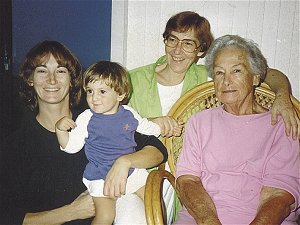
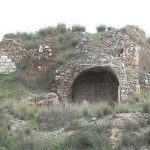
Loved your post. It’s a pity we don’t have these groups here, we work so many hours…
Hi Lisa-
I just read this from beginning to end–it is really interesting.
I makes me feel like I knew your mother better than I really did, too.
It’s really good that you put it on your blog.
Margie
Lisa – I am not sure how I ended up here, but I am sure glad I did. Your mother was such a mentor, teacher and friend for me and our family. Thank you for posting this. I have a photo of Bernice in Jerusalem from that day we spent together and then out to your house. It is on my desk so she is looking over me every day.
Great blog – great posting.
Faithfully yours
Chief